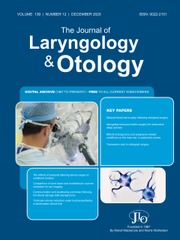Dear Editor,
Based on global statistics, over 34 million children live with disabling hearing loss, and cochlear implants (CIs) offer the critical solution to speech and hearing development.1 However, postoperative rehabilitation remains indispensable, and family efficacy—the parents’ capacity to translate clinical practices into everyday living—remains the determining factor of long-term outcomes. Despite technological advancements, many families lack the knowledge, skills, or structured support to actively engage in rehabilitation, resulting in suboptimal progress.Reference Lukovenko, Sikinbayev, Shterts and Mironova2 There is always such a situation in clinical practice: children’s rehabilitation stagnation is not due to the equipment constraint, but parents believe that cochlear implantation is a “quick fix”, and turn over postoperative rehabilitation completely to institutions. This passive concept leads to self-exclusion of parents from the rehabilitation system, harming the rehabilitation of children.
Emerging evidence underscores the bidirectional relationship between family efficacy and child outcomes. Parental knowledge, attitudes, and practices (KAP) directly correlate with improved speech perception and auditory integration.Reference Lin, Zhang, Chi, Li, Ma and Su3 For instance, children whose parents constantly utilize auditory-verbal strategies (e.g., narrating daily activities) experience a faster language acquisition rate than children with visual only. In contrast, delayed progress exacerbates parental stress and promotes learned helplessness and therefore forms a self-reinforcing cycle of disengagement.Reference Asta, Çinar Sateki, Uzdi and Tokgöz Yilmaz4 Regrettably, the available evidence indicates that compared with institutional rehabilitation only, the mixed rehabilitation mode of family-institutions often performs poorly.Reference Lin, Zhang, Chi, Li, Ma and Su3 This counterintuitive finding reflects untrained caregivers unintentionally reinforcing unhealthy communication patterns, such as oversimplified language input or suppression of complex auditory stimulation. These practices deprive children of the enriched auditory environment critical for neural remodeling.
Prior study by Geers et al. (2003), pointed that broad family characteristics like socioeconomic status (SES) had no significant impact on speech perception outcomes for children with cochlear implants.Reference Geers, Brenner and Davidson5 This conclusion was only based on the macro-level analyses of SES (e.g., parental education or income) and didn’t detail the role of family in postoperative rehabilitation. Recent evidence shifts the focus toward domain-specific family factors, particularly parents’ KAP related to CI rehabilitation—distinct from generic SES metrics. Through auditory-verbal strategies and consistent home-based interventions, actively engaging parents can enhance children’s auditory integration, irrespective of SES. This emerging case underscores that effective family efficacy in rehabilitation hinges more on actionable, rehabilitation-specific competencies that empower parents to translate clinical guidance into daily practice.
While current cross-sectional studies illuminate associations between family efficacy and outcomes, their design obscures causality. Does high KAP drive better outcomes, or do enhanced outcomes motivate parental engagement? Future studies should break such limitations. Longitudinal follow-up that measures parental KAP and child outcomes across time could provide stronger causality. A proposed study design might involve a cohort of children post-implantation, with regular assessments of parental KAP and child rehabilitation progress, supplemented by interviews to explore parental experiences. This would more fully document the bidirectional interaction, direct more focused interventions, and refine the models.
Although advances like AAV1-hOTOF gene therapy offer hope, their accessibility and cost remain prohibitive.Reference Lv, Wang, Cheng, Chen, Wang and Zhang6 Future efforts should prioritize scalable solutions to strengthen family efficacy. Standardized training programs, peer mentorship networks, and community-driven support systems can empower parents with evidence-based strategies. Critically, these efforts align with the WHO’s call for inclusive, family-centered care, emphasizing that clinical innovation must align with the lived realities of families.1
In short, family efficacy is not peripheral but core to the success of CI. Empowering parents as active partners of rehabilitation—equipped with skills, resources, and social support—will unlock the full potential of cochlear implantation and help children accelerate recovery.
What is already known
• Cochlear implants (CIs) are essential for auditory and speech development in children with disabling hearing loss, but long-term outcomes depend on postoperative rehabilitation.
• Parental knowledge, attitudes, and practices (KAP) correlate with child outcomes, but cross-sectional studies struggle to establish causal relationships.
• Institutional-led rehabilitation models dominate clinical practice, yet their effectiveness is limited without active parental engagement.
What this paper adds
• Family efficacy—parents’ ability to apply clinical strategies in daily life—is a critical determinant of rehabilitation success.
• Bidirectional dynamics: Demonstrates the reciprocal relationship between parental KAP and child progress, showing how uninformed practices (e.g., oversimplified communication) inadvertently hinder neural and linguistic development.
• Intervention priorities: Proposes scalable, family-centered strategies (e.g., standardized parent training, peer mentorship) to bridge the gap between clinical innovation and real-world implementation.
4.Methodological advancements: Advocates for longitudinal, mixed-methods research to clarify causality and refine rehabilitation models, addressing limitations of existing cross-sectional studies.
Key distinctions
• Focus on the role of family efficacy in children’s rehabilitation that has not been fully researched and demonstrated
• Integrates qualitative and quantitative evidence to propose actionable interventions.
• Links clinical practice to global health policy frameworks, reinforcing translational relevance.
Conflicts of Interest
All authors declare no conflicts of interest.
Funding
The author(s) disclosed receipt of the following financial support for the research, authorship, and/or publication of this article: This work was supported by Zhejiang Province College Students’ Scientific and Technological Innovation Program and Xinmiao Talent Plan [grant number 2024R413A022] and The National Undergraduate Training Program for Innovation and Entrepreneurship [grant number 202410343015]
Ethics Statement
The letter is written within the ethical standards, as there was no in volvement of human subjects.
Data Availability Statement
Data sharing not applicable to this article as no datasets were generated or analysed during the current study
Author Contributions
All authors contributed to the study conception and design. Material preparation and analysis were performed by Jie Wang and Tuochen Lv. The first draft of the manuscript was written by Tuochen Lv and all authors commented on previous versions of the manuscript. The revised manuscript was revised and corrected by Weiyi Wang. All authors read and approved the final manuscript.

